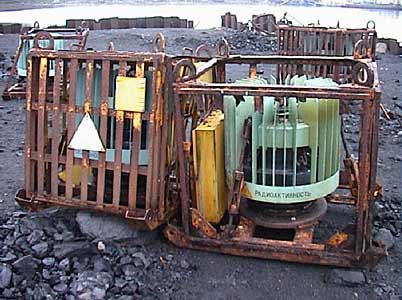Beta-M Soviet RTG Diagram on:
[Wikipedia]
[Google]
[Amazon]
 The Beta-M is a radioisotope thermoelectric generator (RTG) that was used in Soviet-era
The Beta-M is a radioisotope thermoelectric generator (RTG) that was used in Soviet-era
 Some Beta-M generators have been subject to incidents of vandalism when scavengers disassembled the units while searching for
Some Beta-M generators have been subject to incidents of vandalism when scavengers disassembled the units while searching for
Norwegian environmental concerns over Beta-M generators still in useRTG Master Plan Development Results and Priority Action Plan Elaboration for its Implementation
Electrical generators Strontium Nuclear technology in the Soviet Union Energy in the Soviet Union {{nuclear-stub
lighthouse
A lighthouse is a tower, building, or other type of physical structure designed to emit light from a system of lamps and lenses and to serve as a beacon for navigational aid, for maritime pilots at sea or on inland waterways.
Lighthouses mar ...
s and beacons.
Design
The Beta-M contains a core made up of strontium-90, which has a half-life of 28.79 years. The core is also known as radioisotope heat source 90 (RHS-90). In its initial state after manufacture, the generator is capable of generating 10 watts of electricity, almost enough to power a compact fluorescent light bulb with light output equivalent to a 60-watt bulb. The generator contains the strontium-90 radioisotope, with a heating power of 250W and 1,480 TBq of radioactivity – equivalent to some of Sr-90.https://www-pub.iaea.org/MTCD/Publications/PDF/Pub1660web-81061875.pdf Mass-scale production of RTGs in the Soviet Union was the responsibility of a plant called Baltiyets, in Narva, Estonia. The efficiency of thermal input (250 watts) to electric output (10 watts) at 4% is relatively high for an RTG of that era but low compared to larger scale thermal power conversion processes such assteam turbine
A steam turbine is a machine that extracts thermal energy from pressurized steam and uses it to do mechanical work on a rotating output shaft. Its modern manifestation was invented by Charles Parsons in 1884. Fabrication of a modern steam turbin ...
s which reach 30% and more efficiency.
Safety incidents
 Some Beta-M generators have been subject to incidents of vandalism when scavengers disassembled the units while searching for
Some Beta-M generators have been subject to incidents of vandalism when scavengers disassembled the units while searching for non-ferrous metal
In metallurgy, non-ferrous metals are metals or alloys that do not contain iron (allotropes of iron, ferrite, and so on) in appreciable amounts.
Generally more costly than ferrous metals, non-ferrous metals are used because of desirable proper ...
s. In December 2001 a radiological accident occurred when three residents of Lia, Georgia found parts of an abandoned Beta-M in the forest while collecting firewood. The three suffered burns and symptoms of acute radiation syndrome as a result of their exposure to the strontium-90 contained in the Beta-M. The disposal team that removed the radiation sources consisted of 25 men who were restricted to 40 seconds' worth of exposure each while transferring the canisters to lead-lined drums.
References
External links
Norwegian environmental concerns over Beta-M generators still in use
Electrical generators Strontium Nuclear technology in the Soviet Union Energy in the Soviet Union {{nuclear-stub